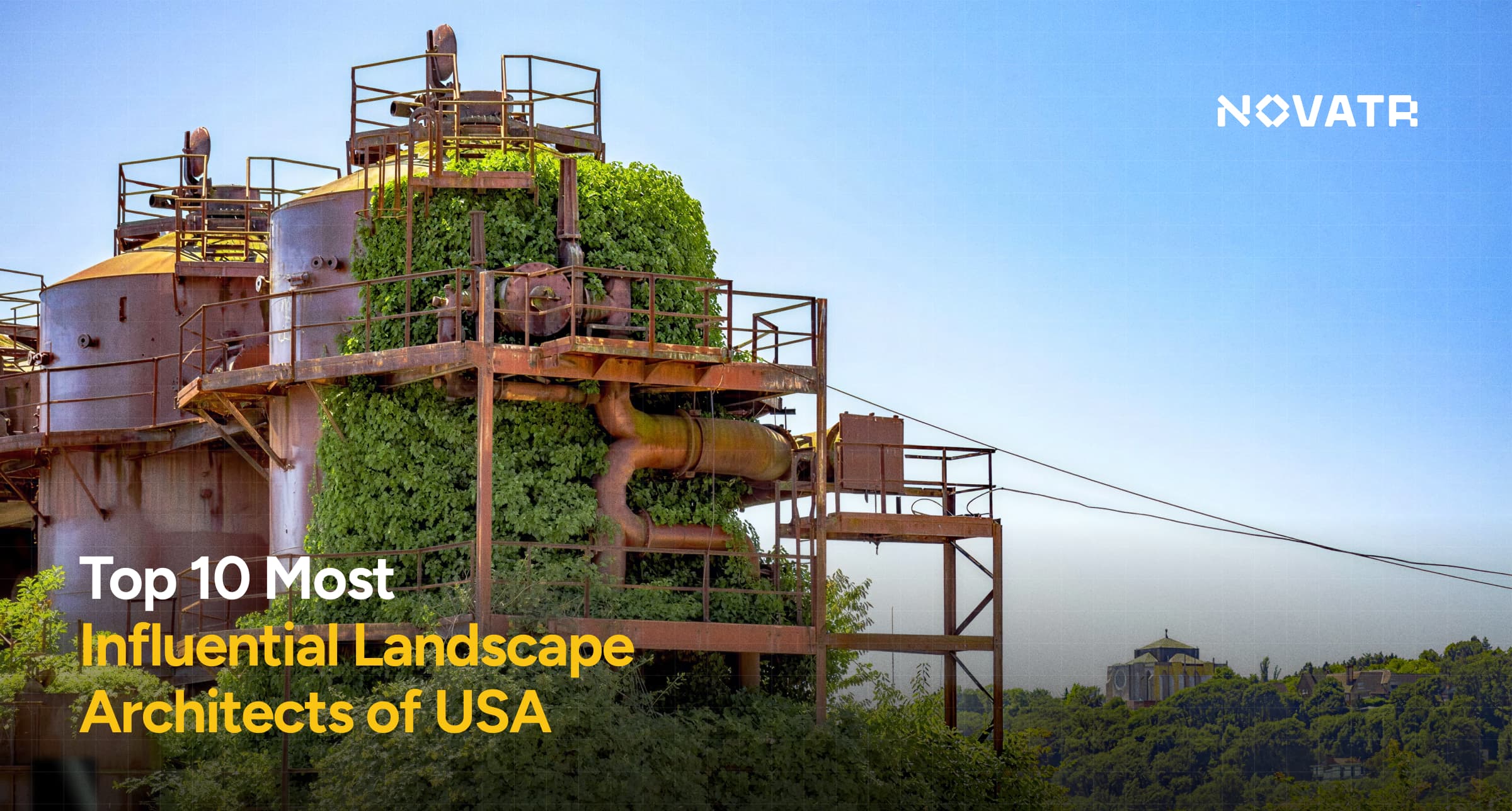
Landscape architecture has been significant in changing the look of our cities, homes, and other public spaces. Both large parks and cozy small gardens are influenced by how famous landscape architects see, use, and design open spaces. The need for more landscaping services and care about sustainability, landscape design, and architecture is more vital in today’s world.
The American Society of Landscape Architects (ASLA) reports that there is fast progress and innovation in the field, with more than 24,000 active professionals contributing to the built environment. Let’s explore the top 10 renowned landscape architects whose guiding principles are worth noting. Know of their most famous designs and lasting impact.
Top 10 Most Influential Landscape Architects in USA
1. Frederick Law Olmsted

Some claim that Frederick Law Olmsted is the first person recognized as a historical landscape architect in the United States, who established the groundwork for modern urban planning. As part of designing New York City’s Central Park, he put importance on creating a balance between the natural and artificial parts of the park.
-
Famous Projects: Central Park (New York City), Prospect Park (Brooklyn), and the Emerald Necklace (Boston).
-
Lasting Impact: Olmsted believed in democratic spaces accessible to all. His integration of nature in cityscapes still guides green landscape architecture and public park systems today.
2. André Le Nôtre
.jpg?width=1092&height=720&name=Gardens%20at%20the%20Palace%20of%20Versailles%20(2).jpg)
Using symmetry and grand ideas, Le Nôtre made the grounds of French royalty beautiful. Thanks to his specific methods, classical landscape design and architecture followed a balanced style. Not only were his gardens beautiful, but they also showed the king’s authority over the environment.
-
Famous Projects: Gardens of Versailles, Vaux-le-Vicomte.
-
Lasting Impact: His influence on residential landscape architecture and monumental design principles continues to inspire popular landscape architects globally.
Also Read: Top BIM Courses With Placements in 2025
3. Beatrix Farrand

The only female founding member of ASLA, Beatrix Farrand, specialized in private estate and university campus design. She overcame significant gender barriers in a male-dominated industry to leave a legacy of elegance and botanical richness.
-
Famous Projects: Dumbarton Oaks (Washington D.C.), Princeton University grounds.
-
Lasting Impact: Farrand’s blend of horticulture with design aesthetics helped define modern landscape projects in educational and private spaces. Her works are considered benchmarks among famous architects of all time.
4. Lawrence Halprin

Halprin was known for integrating user experience and choreography into landscape design and architecture. He believed landscape architecture should be dynamic and interactive, not static. His background in dance influenced his ability to design with movement in mind.
-
Famous Projects: FDR Memorial, Lovejoy Fountain Park (Portland).
-
Lasting Impact: Halprin's dynamic approach aligns with the modern landscape architect job profile, which values user interaction.
5. Roberto Burle Marx

This Brazilian visionary fused abstract art and modernism with tropical vegetation. His groundbreaking use of native plants revolutionized landscape projects in Latin America. Burle Marx was also a painter, sculptor, and environmentalist, which added a rich dimension to his work.
-
Famous Projects: Copacabana Beach promenade, Flamengo Park.
-
Lasting Impact: Marx brought vibrant color and native biodiversity into public spaces, influencing green landscape architecture and sustainable practices. He remains a pivotal figure among famous landscape architects in tropical ecosystems.
6. Thomas Church

A pioneer of the “California Style,” Church made residential landscape architecture both modern and functional. He emphasized indoor-outdoor living and fluid design lines. His work frequently included swimming pools, patios, and outdoor furniture arrangements..
-
Famous Projects: Donnell Garden (Sonoma), General Motors Technical Center.
-
Lasting Impact: Church was one of the popular landscape architects who showed that residential designs could be artistic and user-friendly.
7. Ian McHarg

McHarg revolutionized landscape projects by merging ecology with planning. He introduced a layered mapping system that incorporated soil, water, and vegetation data into design decisions. McHarg’s approach prioritized sustainability before it became mainstream.
-
Famous Projects: Woodlands, Texas; Baltimore’s Inner Harbor.
-
Lasting Impact: Author of “Design with Nature,” McHarg helped embed environmental stewardship into landscaping services worldwide.
8. James Corner
.jpg?width=2592&height=1944&name=The%20highline%20in%20NYC%20(1).jpg)
A modern landscape architect job profile often mirrors Corner’s multidisciplinary approach. His work spans architecture, landscape, urban design, and ecology. Corner emphasizes narrative and transformation in neglected urban spaces. He collaborates closely with artists, ecologists, and engineers.
-
Famous Projects: The High Line (New York City), Fresh Kills Park (Staten Island).
-
Lasting Impact: Corner continues to influence the next generation of best landscape architects through his innovative practice.
Also Read: Landscape Architecture: Definitions, Types, Elements & More (2025)
9. Peter Walker

Peter Walker's work bridges minimalism with monumental scale. His projects demonstrate a deep understanding of geometry and spatial psychology. Walker often uses stone, water, and vegetation in carefully balanced compositions.
-
Famous Projects: National 9/11 Memorial, Glenstone Museum landscape.
-
Lasting Impact: Walker’s clean lines and structural elegance offer a model for civic dignity in landscape design and architecture.
10. Martha Schwartz

Known for her bold, conceptual designs, Schwartz challenges traditional ideas in landscaping services. She experiments with color, texture, and non-traditional materials. Her work often sparks conversation about art and public space.
-
Famous Projects: Jacob Javits Plaza (New York), Splice Garden (Cambridge).
-
Lasting Impact: She brings pop art into landscaping, proving the field can be both functional and provocative. Schwartz’s creative legacy is studied by today’s renowned landscape architects.
What Lessons Can Future Architects Learn From Them?
These renowned landscape architects were not just designers; they were visionaries who understood the relationship between people, nature, and space. Their careers offer essential case studies for today’s professionals.
From Olmsted’s egalitarian parks to Schwartz’s playful interventions, each demonstrated how famous landscape architects can shape culture, community, and sustainability. Lessons include:
-
Contextual Sensitivity: Successful designs respect natural topography and community history.
-
Innovation Through Collaboration: Many worked closely with architects and city planners.
-
Sustainability and Stewardship: A recurring theme across time.
For those aspiring to the landscape architect job profile, these examples offer both artistic inspiration and ethical guidance.
Also Read: How BIM for Landscape Design is Redefining the Future of Landscape Design
Conclusion
As cities grow and environmental challenges intensify, the role of famous architects of all time in landscape architecture becomes ever more crucial. From Versailles to the High Line, these best landscape architects who prove that design is not just aesthetic, it’s civic, ecological, and deeply human with meaningful, future-focused landscape projects.
Explore the Building Information Modeling Course for Architects by Novatr and join the next wave of sustainable designers, planners, and creators reshaping our world.
Visit our resource page to get started and explore expert guidance on advancing your career.
FAQs
1. Who are the most influential landscape architects in the history of the USA?
Frederick Law Olmsted, Beatrix Farrand, Lawrence Halprin, Ian McHarg, James Corner, and Peter Walker are among the most famous landscape architects in American history.
2. What are some notable projects by top American landscape architects?
Notable landscape projects include Central Park (Olmsted), Dumbarton Oaks (Farrand), FDR Memorial (Halprin), and the High Line (Corner). These sites have shaped the evolution of landscape design and architecture.
3. How have influential landscape architects shaped public spaces in the USA?
Through vision, innovation, and sustainability, renowned landscape architects have transformed public spaces into inclusive, green, and interactive environments.
Was this content helpful to you



.jpg)




.png)
.png)

